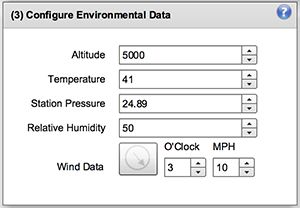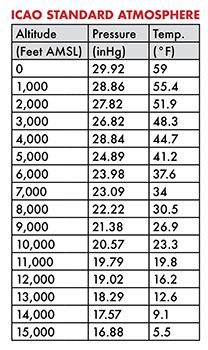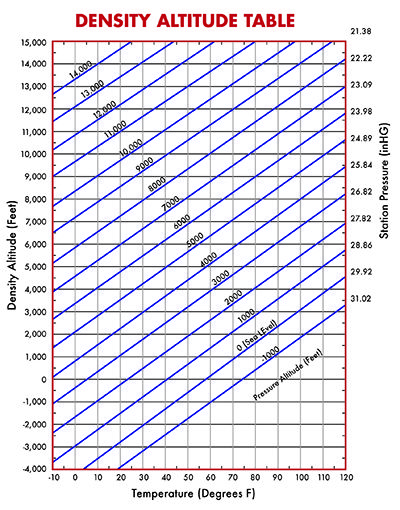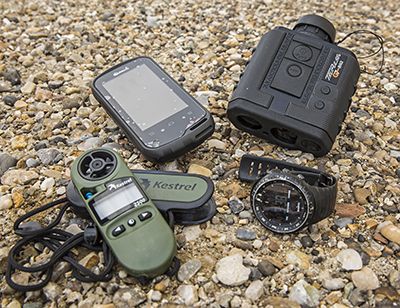I know I’m running the risk of creating an article that reads like a textbook, but I feel strongly that this is the most common area of mistaken inputs when making ballistic calculations. I want to systematically explore air pressure topics so that we all have common nomenclature and basic understanding of measurement and reporting systems. We will start with a general discussion of air pressure, definition of terms, measurement devices, and then finish with some alternative ways to use pressure data when calculating ballistics.
AIR PRESSURE
Let's start by defining atmospheric pressure as the force per unit area (eg psi) exerted on a surface by the weight of air above that surface. This surface is assumed to be in the atmosphere. The ICAO standard pressure at sea level is 29.92 in Hg, this is approximately 14.7 psi. So if we do a unit analysis on a surface at sea level that is one inch by one inch, we would find that the weight of the air from the surface to the top of the atmosphere would be about 14.7 lbs!
The standard atmosphere (symbol: atm) is a unit of pressure equal to 101325 Pa[1] or 1013.25 millibars. Equivalent to 760 mmHg, 29.92inHg, 14.696 psi.
BASIC BALLISTICS OVERVIEW
To get an accurate correction for long range shots, a ballistic program needs to model the air density. Air Density is the air pressure, temperature, and humidity. Air pressure is commonly referenced two ways: absolute pressure and pressure corrected to sea level conditions. We will refer to absolute pressure as station pressure. This is the actual pressure measurement at the measurement point. If you are on the ICAO standard and with standard weather conditions, at sea level, your station pressure will be 29.92 inHg. If you are in Cody Wyoming, your elevation could be around 5000 feet. The ICAO pressure at this elevation is 24.89 inHg. It's significant that you remember that station pressure will decrease as you gain elevation. As a rough order of magnitude calculation, your absolute pressure will decrease approximately 1 inHg for every 1000 feet of elevation increase.
We will refer to corrected pressure as barometric pressure. This is the pressure condition reported as if from sea level, regardless of actual altitude. Also known a sea level barometric pressure. Barometric pressure is what is commonly reported by your local weather service. It is corrected to sea level so that we have a common reference for pressure changes (usually for weather prediction). Let's look at the previous example using barometric pressure. At sea level and standard conditions for ICAO, we would measure 29.92 inHg. This is the same as the station pressure reading from the prior example. However, measuring the barometric pressure for standard weather conditions at the same Cody Wyoming location of 5000 feet elevation shows 29.92 inHg -- a clear difference from a station pressure of 24.89! If you made the mistake of using barometric pressure instead of station pressure on a ballistic calculation, you would have seen a drop error of 20 inches or more at 1000 yards!
Many ballistic programs will allow either input. If you use barometric pressure, you will also be required to enter the elevation at which the bp reading was taken. The ballistic software will calculate the approximate station pressure and use the calculated sp in the ballistic solution. With station pressure, you will only be required to input a single variable - pressure. That alone indicates a simpler approach. Because the station pressure is used directly for most programs, and it does not run through a conversion calculation, the result will be slightly more accurate.
Along the same lines as using barometric pressure, some programs will allow alternate input methods to determine pressure. See the inset for the G7 Ballistic Program environmentals input screen. The G7 program will allow a user to specify elevation of the shooter (altitude of the bullet in flight). Then it automatically populates the ICAO standard station pressure and temperature in editable fields that can be refined as needed. The ballistic solution is based on the station pressure and temperature lines, not the altitude. The ICAO standard conditions chart shows the station pressure and temperature for a range of elevations. A ballistic program will use a detailed version of this chart, or a representative algorithm to identify exact variables.

Other programs will use different methods to get these inputs. Make sure you understand how the program works, remembering that they are generally trying to render out station pressure for the final ballistic solution.
One method of note is density altitude. Using Density Altitude when calculating a ballistic solution can reduce the number of variables that a user has to translate from a measurement device and to a ballistic computer. Density Altitude basically combines pressure, temperature, and humidity into a single number. Density altitude in the simplest definition is pressure altitude corrected for non-standard temperature. If we look at a chart, we can easily convert an elevation (or station pressure) and temperature into a density altitude. First, find your station pressure in the right hand column, and trace the blue line diagonally downwards to the left until it intersects the grey temperature line. From this point follow the black line to the left to the Density Altitude scale. Alternatively, if you know your approximate elevation, go right to the pressure altitude line and intercept your temperature. Finally, follow the black line to your Density Altitude.


MY MEASUREMENT TOOLS
Technically, I don’t worry about the station pressure anymore. I use the G7 BR2 rangefinder when I’m hunting, and I just press the button and shoot the calculated solution. I can access the measured values menu and see the measured station pressure, and the calculated pressure altitude. On a hunt, I also have my trusty Suunto watch that will give me station pressure and temperature, I can watch these numbers and be aware of potential air density point of impact effects. I usually have a wind meter in my kit, and I carry a Kestrel 2500 that will also measure and report pressure and temperature. This device gets used for only the longest and most technical shots. I rarely access the atmospheric data. However, on higher end models, you can bluetooth the pressure and temperature directly into your handheld ballistic calculator or use one of the kestrels with ballistics. I’ve never liked carrying my phone into the field, but with the new Garmin Monterra, I can install all my android ballistic apps for a rugged field solution for GPS and ballistics. This device also measures pressure. That's my kit. One thing you will notice is redundancy!

The most important thing to apply from this article is to identify your preferred workflow to obtain a ballistic solution. For some, an integrated device like the G7 BR2 or Kestrel with ballistics keeps the solution simple and eliminates the need to measure or input pressure information. For others, especially BDC turret users without a BR2, you may need to keep track of changing conditions and change turrets or make adjustments to your solution based on actual conditions. Once you’ve defined how you will use your data, then you can identify the devices and procedures required to measure and adjust for changing air pressure. For anyone shooting long range and especially hunting at distance, its imperative to understand what is going on inside your devices. Sooner or later it will save your hunt.

Shooting Under Pressure